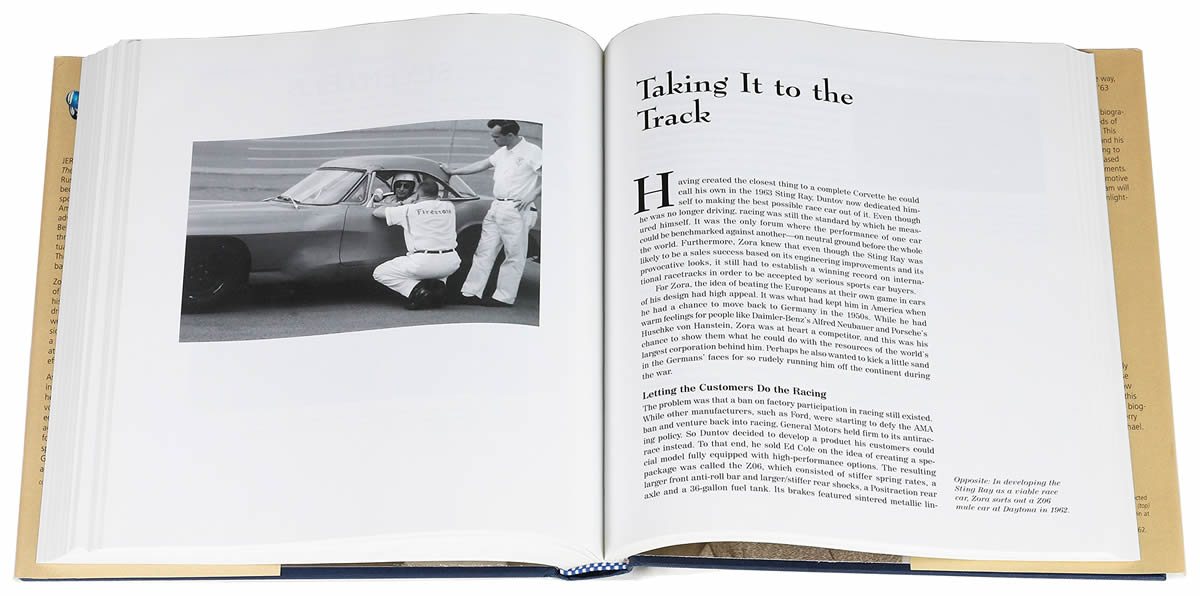Visit a book store with an automotive section look right at Amazon.com. You’ll find many books about Corvettes: engine building, racing, restoration, facts-and-figures, service manuals, coffee-table picture books, parts books, assembly manuals, collections of reprinted magazine articles and a variety of other titles. Like I said…there are lots of Corvette books.
As for great Corvette books?
Well…those are pretty darn rare. Karl Lugvigsen’s classic, Corvette: America’s Star-Spangled Sports Car, is one. The late Jim Schefter’s, All Corvettes are Red, is another. Noland Adam’s pair of Corvette Restoration and Technical Manuals are two more.
Another example of truly outstanding Corvette literature is Jerry Burton’s biography, Zora Arkus-Duntov: the Legend Behind the Corvette. Finely-detailed, yet easy-reading, it’s a spellbinding life’s story of a man who became one of the automotive engineering giants of the 20th Century.

This book also tells of Duntov’s growing up in St. Petersburg during the Russian Revolution when young Zora was a street-wise, risk-taker who sometimes carried a pistol and more than once used it to defend himself. It also tells of newly-married Zora and Elfe’s Duntov’s frantic escape across southern France just ahead of the Nazi juggernaut in the early days of World War II? You’ll read about Duntov’s arrival in New York City, just before the U.S. entered WW2, where, inside of three weeks, he borrowed money, started a business and, within months was a runaway success as a defense contractor? The book explains Duntov’s initial success in the car business came as a manufacturer of parts for Ford V8 engines? It tells about how he raced Porsches at Le Mans while he engineered Corvettes at GM? You’ll learn that Zora was quite the “chick-magnet” jet-setter who hung-out with the high-society, political, entertainment and international motorsports personalities that made news in the 1950s and 1960s? All this and more of Duntov’s amazing life is in Burton’s book.
Not only was Zora a wonderfully talented and visionary engineer but he had his limitations, too. He cheated on his wife, partied too much, drove too fast and pissed-off half the executives at GM right up to the CEO. He loved the Corvette, worked hard to make it better and strived to promote it, not only to the public, but, also, to the company that was making it because, in the car’s early years, half the time, GM didn’t know what to do with Corvettes and the rest of the time it didn’t want them at all.
Through painstaking research and a affable style, Burton weaves all these colorful aspects of Zora Arkus-Duntov’s life into a highly-captivating story. The book is decidedly non-technical, one of its major strong points. Each chapter is a short-story in itself, encompassing a particular period or aspect of Zora’s life. The book is remarkably unbiased, covering Duntov’s strengths and his weaknesses but expressing few opinions. It’s smooth writing style and easy reading make it outstanding entertainment as well as an excellent work of biography.
Even casual students of the history of the American automobile industry must have “Zora Arkus-Duntov” in their library.
Jerry Burton has been a Corvette enthusiast since his early years working for Campbell-Ewald in Detroit. He was the creative genius behind the Chevrolet “Heart Beat of America” theme. He was the first Editor of he now-defunct “Corvette Quarterly”. He is, also, a former Board Member of the National Corvette Museum. Over the years, he became close friends with Zora. That friendship drove an interest in profiling the man’s life and personality which became this first comprehensive biography of Zora Arkus-Duntov.
For more information, visit the Bently Publishers web site

